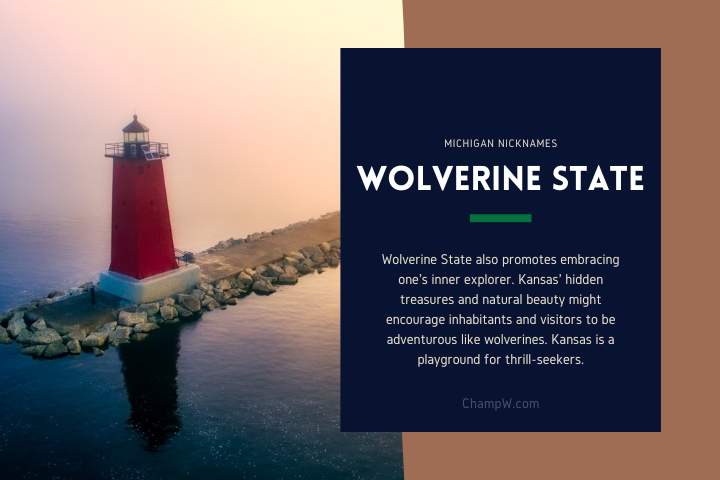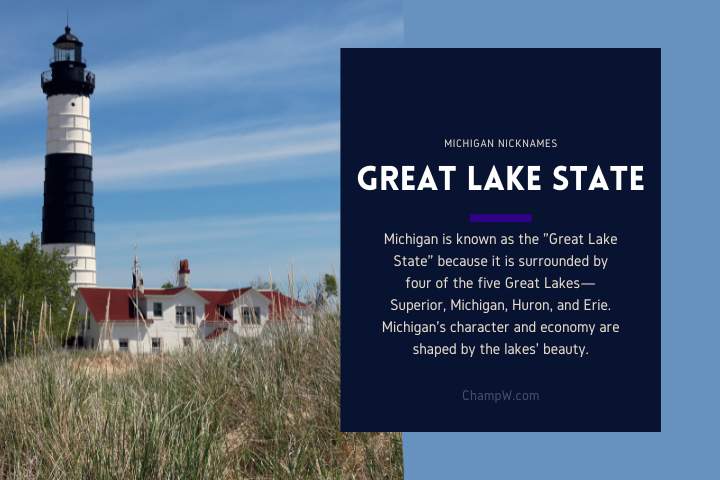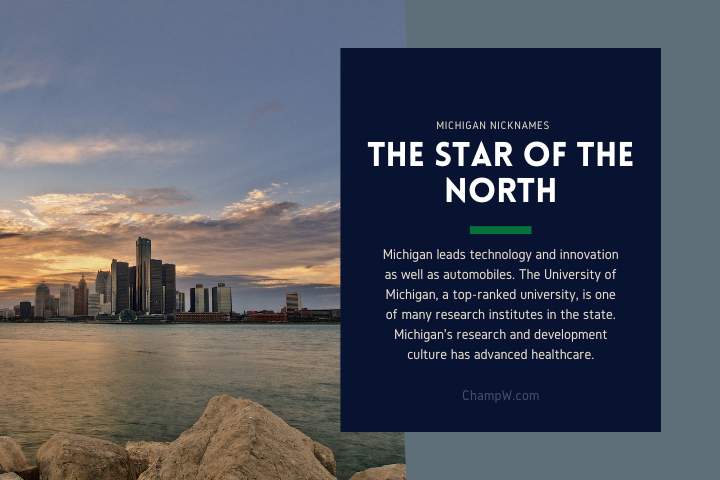Our site explores Michigan’s rich moniker history. Michigan, the “Wolverine State” and “Great Lakes State,” has captivated residents and visitors with its diverse landscapes, lively cities, and rich history. This blog will explore the origins and meanings of these warm Michigan Nicknames, highlighting the unique attributes that make Michigan a valued and distinct location. Join us as we explore Michigan’s nicknames to discover its actual nature.
We examine Michigan’s rich history of nicknames here. Michigan, the “Great Lakes State” and “Wolverine State,” has captivated locals and visitors alike. Join us as we uncover the stories that have molded Michigan’s identity and increase our appreciation for this magnificent place.
Michigan has been called the Great Lake State and the Wolverine State. Each nickname symbolizes the state’s cultural, geographical, and historical diversity.
Michigan Nicknames
Join us as we explore Michigan nicknames and discover what makes this state special. Relax and enjoy Michigan’s charming nicknames’ fascinating stories.
1. Great Lake State
Michigan is known as the “Great Lake State” because it is surrounded by four of the five Great Lakes—Superior, Michigan, Huron, and Erie. Michigan’s character and economy are shaped by the lakes’ beauty.
The term “Great Lake State” recognizes Michigan’s close relationship with the lakes and their importance in its history and development. The lakes have been key transit routes, enabling trade and economy throughout the region. They have also provided abundant fish and freshwater for the state’s fishing sector and agriculture and drinking.
The Great Lakes also shaped Michigan’s culture and recreation. Tourists and locals enjoy boating, swimming, and other water sports on the lakes. The gorgeous coasts, sandy beaches, and breathtaking sunsets have inspired artists, writers, and musicians, creating a rich cultural history.
The term “Great Lake State” represents Michigan’s strength and energy. Michigan has faced adversity like the lakes, which can be calm or violent. The state’s citizens have overcome economic downturns and natural disasters with extraordinary resilience.
2. Port City
Michigan’s “Port City” nickname is less well-known than the “Great Lake State,” but it’s important to the state’s history and prosperity.
Michigan, the “Port City,” has a strong maritime industry. The state’s Great Lakes position has made it a transportation and trade hub for millennia. Michigan’s many ports have opened markets, boosting economic growth.
The term “Port City” emphasizes Michigan’s industrial supremacy and manufacturing background. Detroit and Grand Rapids became industrial hubs in the 19th and 20th centuries. These communities received iron ore and lumber and shipped completed products to national and international markets.
“Port City” highlights Michigan’s multiculturalism and different immigrant communities. Michigan’s diverse population is enriched by its ports. These various communities enriched the state’s traditions, food, and arts.
“Port City” also emphasizes Michigan’s environmental stewardship. The state values conserving its waters and delicate ecosystems due to its large coastline and natural beauty. Michigan leads environmental measures by promoting sustainability, conserving resources, and preventing pollution.
3. The Mitten State
Michigan’s distinctive shape gives it the nickname “Mitten State.” This moniker represents Michigan’s geography and a strong sense of togetherness and identity. Michiganders are like mittens, protecting each other. Residents proudly call themselves “Michiganders,” recognizing their shared identity and ideals. The state’s support for sports teams like the Detroit Tigers and the University of Michigan Wolverines and its many volunteer and community service efforts show this cohesiveness.
“Mitten State” also stresses Michigan’s education and intellectual progress. Michigan State University and the University of Michigan are prominent research universities in the state. These institutions have produced many intellectuals, scientists, and innovators who have advanced many fields.
The mitten symbolizes Michigan’s natural beauty and outdoor leisure. The state has many forests, lakes, and attractive landscapes for hiking, camping, fishing, and other outdoor activities. Michiganders value their state’s natural resources and work to preserve and display them.
The “Mitten State” appellation also honors Michigan’s history and culture. The state boasts a complex cultural tapestry of Native American tribes, French fur traders, and European settlers. Michigan’s museums, historical sites, and festivals preserve and celebrate its past.

4. The Peninsula State
The Great Lakes divide Michigan into the Upper Peninsula and Lower Peninsula, giving it the nickname “Peninsula State.” Michigan’s identity, culture, economy, and natural resources are formed by its distinctive terrain. The Upper Peninsula (UP) is noted for its rough nature and plentiful natural resources. Forests, waterfalls, and mountains dominate this region, offering spectacular views and outdoor enjoyment. UP culture is shaped by Native American tribes and mining and logging. UP residents value their independence, resilience, and connection to the land.
However, Michigan’s cities and industries are concentrated in the Lower Peninsula. Detroit, Grand Rapids, and Ann Arbor are lively cities with various cultural, economic, and educational options. The Lower Peninsula’s economy includes manufacturing, automotive, technology, and healthcare. The Sleeping Bear Dunes National Lakeshore and other scenic beaches draw tourists and outdoor lovers.
The moniker “Peninsula State” emphasizes the interconnectedness of these two diverse regions and the significance of unity and collaboration despite physical limitations. Despite their different landscapes and cultures, Upper and Lower Peninsula Michiganders share a state identity.
The Upper-Lower Peninsula split affects Michigan’s natural resources and ecosystem. Lake Superior, Lake Michigan, and Lake Huron border the state’s peninsulas. These waterways supply freshwater and shipping channels, but pollution, invasive species, and water management are issues. Michigan residents and government must preserve the Great Lakes for future generations.
5. The Star of the North
Michigan is known as the “Star of the North” due to its northern position and industry leadership. Michigan’s automobile industry shows its “Star of the North” status. Detroit, the Motor City, is the center of the American auto industry. Michigan-based Ford, General Motors, and Chrysler have shaped the automobile industry. Michigan’s manufacturing, engineering, and innovation capabilities attract automobile fans and experts from around the world.
Michigan leads technology and innovation as well as automobiles. The University of Michigan, a top-ranked university, is one of many research institutes in the state. Michigan’s research and development culture has advanced healthcare, renewable energy, and information technology.
Michigan’s beauty also makes it the Star of the North. Great Lakes, woods, and sand dunes make the state beautiful. These natural attractions boost Michigan’s tourism business. The state’s dedication to environmental protection, sustainability, and natural resource preservation boosts its conservation and eco-tourism reputation.
Michigan’s courage in adversity is symbolized by the Star of the North nickname. The state has overcome economic setbacks like the auto industry’s demise. Michigan’s varied economy, which includes healthcare, technology, and tourism, shows its adaptability.
6. Land of 10,000 lakes
Minnesota is known as the “Land of 10,000 Lakes,” but Michigan has an astounding number of inland lakes. Michigan has 11,000 inland lakes for boating, fishing, and water enjoyment. These lakes help Michigan’s reputation as a natural resource-loving state. Michigan’s many lakes provide recreation and support the state’s environment. These waters support fish, amphibians, and birds. They support state biodiversity by providing plant habitats. These lakes will thrive for decades because to Michigan’s conservation efforts.
Lakes also affect Michigan’s economy. Tourism relies on these lakes’ natural beauty and leisure activities. Boating, swimming, and touring Michigan’s lakefront villages draw tourists from throughout the nation. Tourism boosts local economies and creates jobs.
Michigan’s “Land of 10,000 Lakes” moniker emphasizes water conservation and management. Michigan prioritizes sustainable water management due to climate change and population expansion. The state implements policies and measures to sustain its lakes and freshwater resources. Michigan’s aggressive water conservation shows its prudent stewardship and inspires other states with comparable issues.
7. Water Winter Wonderland
Michigan’s “Water Winter Wonderland” appellation reflects its unique blend of natural beauty and winter leisure activities. Michigan becomes a wintry wonderland in winter, attracting winter sports lovers from near and far. Michigan offers skiing, snowboarding, ice fishing, and snowmobiling. Ski resorts in the state offer excellent downhill and cross-country trails to locals and visitors. The state’s winter attractiveness includes ice fishing and skating on frozen lakes and rivers.
This winter wonderland motif stresses Michigan’s natural resources and leisure options’ connection. Winter sports are beautiful in the state’s icy woodlands. Lakes, which are prominent in summer, are also important in winter sports. Ice fishing, skating, and snowmobiling are popular on frozen lakes.
The winter wonderland theme also shows Michigan’s adaptability to hard winters. The state’s tourism business has invested in winter activity infrastructure and services. Chairlifts, snowmaking machines, and pleasant lodges enhance winter experiences at ski slopes.
Michigan’s “Water Winter Wonderland” nickname shows its year-round environmental stewardship. The state supports appropriate winter recreation to preserve its natural resources. Protecting wildlife habitats and following ice fishing and snowmobiling rules reduces environmental effect.
8. Lady of the Lake
Michigan’s “Lady of the Lake” nickname, inspired by the state’s many lakes, highlights the state’s natural beauty and attractiveness. Michigan’s love of water and its identity are reflected in the “Lady of the Lake” concept. Lakes, from little ponds to Lake Michigan and Lake Superior, offer stunning beauty and plenty of recreation. Michigan’s lakes aren’t simply beautiful and fun—they’re vital to its economy and environment. The Great Lakes provide transportation, tourism, fishing, and energy generation. They sustain different ecosystems for plant and animal species.
“Lady of the Lake” emphasizes water conservation and care. Michigan knows that these waters are delicate and must be safeguarded for future generations. The state regulates pollution, invasive species, and water management.
“Lady of the Lake” refers to Michigan’s lakes’ great cultural and historical significance. These waters are sacred to Native Americans. From Native American settlements to European colonialism, the lakes have shaped the state’s history.
The state’s many museums, historical sites, and interpretive centers demonstrate Michigan’s commitment to lake heritage preservation. These institutions educate visitors about the value of lakes and the need to protect them.
9. Land Of Snow Machines And Bass Boats
Michigan’s affinity with winter and summer recreation ties into its “Star of the North” concept. In addition to winter sports and snowy vistas, the state has several summer outdoor activities. Michigan’s “Land of Snow Machines” nickname comes from its plentiful snowfall and winter sports facilities. Ski resorts, snowmobile paths, and ice-fishing draw winter sports lovers to the state. These sports let you enjoy Michigan’s natural beauty while sliding down the slopes or zipping over frozen lakes.
Michigan’s recreation goes beyond winter. Boaters and anglers love the state’s lakes and rivers. Michigan’s bass fishing is popular, hence the “Bass Boat” theme. Anglers from around the world come to Michigan to catch a big fish in peaceful nature.
Michigan includes hiking, biking, camping, birdwatching, skiing, snowmobiling, boating, and fishing. The state’s rich forests and sandy beaches offer endless exploration and adventure. Isle Royale National Park offers magnificent walks, the Great Lakes Waterfront Trail offers bike rides along Lake Michigan, and Pictured Rocks National Lakeshore offers campfires beneath the stars.
These summer events promote Michigan’s year-round enjoyment and environmental care. To ensure future generations can enjoy the outdoors, Michigan preserves its forests, marshes, and animal habitats.
Michigan embraces winter sports, summer recreation, and environmental preservation to show its diverse and multifaceted identity as the “Star of the North.” Whether visitors are looking for the thrill of a snowy adventure, the tranquility of a fishing trip, or the awe-inspiring beauty of its natural landscapes, Michigan has something for everyone. Michigan’s genuine nature emerges as the seasons change and the landscapes come to life, enthralling those who experience it.
10. Auto State
Michigan’s automotive industry ties into its “Star of the North” concept. The state’s nickname, the “Auto State,” reflects its long history of car development and production. Automotive manufacturing began in Michigan. Ford, General Motors, and Chrysler made Detroit the automobile capital of the globe. The automotive sector attracted millions of workers and transformed global transportation.
Michigan is home to many automobile manufacturing plants, R&D centers, and related enterprises. Michigan’s culture and identity reflect this tradition.
The Auto State theme emphasizes the automobile industry’s importance on Michigan’s economy, education, and community. The industry has created many jobs, boosting the state’s economy. It also encourages innovation and entrepreneurship, with numerous people and companies developing and manufacturing cutting-edge automotive technologies.
The University of Michigan and Kettering University have helped develop automotive talent in Michigan. Students from throughout the world study automotive engineering, design, and management at these universities.
The Auto State motif also emphasizes Michigan’s close-knit community and automotive pride. The North American International Auto Show in Detroit showcases the latest technology and celebrates automotive design. This event promotes friendship, excitement, and Michigan’s devotion to the automobile sector.
Michigan strengthens its worldwide automotive leadership by adopting the Auto State concept. The state’s partnerships with automakers, suppliers, and technology businesses ensure its sustained relevance and influence in determining transportation’s future. From Detroit’s assembly lines to Ann Arbor’s test tracks, Michigan’s Auto State theme represents quality, innovation, and automotive growth.
11. The Wheat State
Michigan is known as the Auto State, while other states have nicknames based on their industry contributions. Kansas—the Wheat State—is an example. While less well known, this nickname represents Kansas’ strong agricultural roots and wheat output. Kansas has plenty of fertile ground for farming. The state’s fertile soil, abundant sunshine, and mild climate are ideal for wheat farming. Kansas farmers have grown wheat for decades.
The Wheat State theme stresses Kansas’ agricultural success and the wheat industry’s enormous impact on the state’s economy, culture, and environment. Wheat’s local and international trade drives the state’s economy. Kansas is one of the top wheat-producing states in the US, providing high-quality wheat for bread and beer.
The Wheat State theme also includes Kansas’s farming traditions and agricultural heritage. Farming families have passed down their skills and devotion to sustainable agriculture for generations. Kansans cherish the farming community’s hard work and tenacity as part of their identity.
The Wheat State theme also shows how Kansas neighbors help each other harvest the crop during harvest season. This camaraderie and reciprocal assistance strengthen the agriculture business and builds Kansan pride. The Kansas Wheat Festival celebrates the Wheat State’s agricultural heritage and unites communities.
Kansas cements its agricultural leadership by adopting the Wheat State theme. Innovation and sustainability assure the state’s wheat production’s success and relevance. From the amber waves of grain that spread across the horizon to the flour mills that process the harvested wheat, Kansas’ Wheat State motif represents excellence, productivity, and world nourishment.
12. The Bread and Butter State
The Wheat State term also emphasizes wheat’s importance in feeding people worldwide. Kansas is known as the Bread and Butter State because wheat is a staple grain and feeds people. Many cultures rely on bread, made from wheat flour. Kansas is the Bread and Butter State because wheat is one of the world’s most essential foods. Wheat supplies nourishment and energy for endless meals.
The Bread and Butter State theme also examines Kansas’ wheat culture. Bread has always brought families and communities together around the dinner table. Breaking bread in Kansas strengthens relationships. The bread symbolizes warmth, comfort, and shared times, whether it’s toast or homemade.
Bread and Butter State also highlights wheat production and consumption problems and advances. Kansas farmers have sought to increase wheat quality, yield, and sustainability so future generations can benefit from it. Milling and baking technologies have improved wheat use, giving consumers more bread options.

13. The Automotive State
Kansas becoming the Automotive State is another Wheat State theme. Kansas is known for its agriculture, but it also makes cars. Kansas’ economy has been diversified by the auto industry. Automotive makers like Kansas’ central position and transportation. Kansas’ roadways and rails provide efficient automobile and part transit to important markets. This strategic edge has attracted automotive manufacturers and assembly lines to Kansas, creating new jobs and investments.
Kansas’ agricultural and automotive industries work together under the Automotive State theme. Diversifying and leasing land for automobile testing, research, and development has helped many farmers. This agriculture-automotive combination boosts the state’s economy and shows Kansans’ innovation and entrepreneurship.
The Automotive State theme emphasizes Kansas’s significance in transportation’s future. Kansas is becoming a leader in sustainable and electric automobiles. Demand for eco-friendly cars matches the state’s commitment to clean energy and environmental conservation. Kansas is leading the automobile industry’s sustainable transition, from electric vehicle component manufacture to charging infrastructure.
The Automotive State motif also acknowledges Kansas’s car culture. Cars represent freedom, mobility, and discovery. They have opened up new adventures and connections for travelers. Kansas’ picturesque roadways are great for road excursions and experience the state’s natural splendor. Kansas, the Automotive State, celebrates and enhances these experiences.
14. Pure Michigan
The Wheat State appellation is sometimes compared to Pure Michigan. Michigan is famous for its natural beauty, while Kansas is known for its agriculture and auto sector. Michigan Economic Development Corporation’s Pure Michigan program promotes tourism and the state’s natural beauty. Kansas’ Wheat State label highlights its agricultural background, whereas Pure Michigan highlights its natural resources. Lakes, coasts, forests, and wildlife abound in Michigan. The campaign’s intriguing ads invite visitors to explore Pure Michigan’s stunning surroundings.
Kansas’s hidden natural gems might be highlighted with the Pure Michigan theme. Known for its agriculture, the state also has several natural attractions. Kansas has peaceful rivers, plains, grasslands, and hills. These environments offer hiking, camping, fishing, and wildlife viewing. Kansas may attract more visitors by adopting the Pure Michigan approach.
Pure Michigan can promote environmental protection and sustainable tourism while promoting the state’s natural features. Kansas may use similar methods to preserve its natural treasures and ensure future generations can enjoy them. Kansas may demonstrate its environmental responsibility by boosting eco-tourism.
The Pure Michigan concept can also inspire pride in Kansas’ natural beauty. The campaign would draw tourists and inspire locals to explore and engage with their state. Kansas might emulate Michigan’s successful campaign to promote its natural heritage and allow visitors to uncover its hidden jewels.
15. America’s Left Hand
America’s Left Hand relates to Kansas’ natural beauty and road excursions. Kansas, in the heart of the US, is known as “America’s Left Hand” due to its hand-shaped shape. Kansas’ position as America’s Left-Hand allows for unlimited adventure and connections, much like road vacations. Cross-country road excursions often begin in Kansas, the western gateway. From Kansas, visitors can enjoy the Rocky Mountains, Yellowstone, the Grand Canyon, and California’s magnificent coastline.
America’s Left Hand emphasizes Kansas’ cultural and historical relevance. The Oregon Trail and Santa Fe Trail passed through the state, helping the US westward expansion. Explore these historical pathways to connect with the pioneers and settlers who built the American West.
Kansas’ center location allows cultural exchanges and regional blending. Kansas connects Eastern and Western civilizations like a road trip. Kansas has a diverse culture, from Kansas City’s arts scene to western Kansas’ cowboy culture.
Kansas can highlight its unique position as a destination that offers natural beauty and access to amazing activities and connections across the US by exploring America’s Left Hand. Kansas is the excellent beginning point for a tour that highlights America’s beauty, history, and diversity.
16. Michigan Mitten State
Michigan Mitten State is related to Kansas’ natural beauty and road travel. Michigan, like Kansas, is called America’s Left Hand because of its shape, which resembles a mitten. Kansas and Michigan show how states are related and have unique geographical features. Kansas may learn from Pure Michigan’s success in showcasing the Mitten State’s natural beauty.
The Flint Hills, Monument Rocks, and prairies of Kansas are beautiful. Kansas can unite with Michigan as the Mitten State to showcase both states’ natural splendor and attract tourists.
The Michigan Mitten State concept promotes unity and connectedness between areas. Kansas can emphasize its sections like Michigan’s thumb represents the Upper Peninsula, a distinct territory with its own attractions. Wichita has a strong metropolitan culture, Topeka offers historical landmarks, and the countryside is peaceful. Kansas may foster pride in its different landscapes and communities by highlighting regional diversity.
Kansas can also explore state travel with the Michigan Mitten State theme. Kansas residents can take road trips to see Michigan’s attractions and natural wonders, too. Kansas may promote local pride and tourism by encouraging Kansans to visit their own state.

17. The Orange Barrel State
The “Orange Barrel State” refers to the summertime sight of orange construction barrels on Kansas highways. Road construction is inconvenient, yet it represents progress, expansion, and improvement. Kansas may promote its infrastructure development and travel experience for inhabitants and tourists by adopting the Orange Barrel State concept. Kansas may enhance roads to make vehicle trips fun and safe.
The Orange Barrel State motif encourages transition and transformation inquiry. Kansas may highlight its ever-changing attractions and places like road construction. Kansas is continually changing and offering new experiences to visitors, from new museums and cultural institutions to revitalized historic sites.
The Orange Barrel State theme also honors Kansas’ flexibility. Kansans are patient and resilient when dealing with road construction delays. Kansas can attract adventurers and explorers by highlighting this spirit.
18. Wolverine State
Another theme tied to Kansas as a road trip destination is the “Wolverine State,” a tough and adaptable animal associated with Michigan. Kansas can highlight its related landscapes, communities, and people by adopting this theme. Extreme temperatures, tornadoes, and thunderstorms make Kansas weather unpredictable. However, like the Wolverine, Kansans have adapted to these meteorological problems. Kansas can display its resilience using this subject.
Wolverine State also promotes embracing one’s inner explorer. Kansas’ hidden treasures and natural beauty might encourage inhabitants and visitors to be adventurous like wolverines. Kansas is a playground for thrill-seekers.
Kansas celebrates its unique fauna and natural beauty with the Wolverine State theme. Kansas has a diversified ecosystem like Wolverines. Kansas can draw nature lovers to its unique ecosystems and breathtaking scenery by stressing environmental conservation and ethical tourism.
The Wolverine State motif also highlights the state’s reliance on outdoor recreation and adventure tourism. Kansas may encourage hunting, fishing, and wildlife photography, just like Michigan’s tourism business benefits from its outdoor activities like fishing, hiking, and camping. Kansas can thrive sustainably by investing in and promoting these activities to locals and tourists.
Also Read:
- 50+ New York City Nicknames: The City That Never Sleeps
- 20+ New Orleans Nicknames: The Stories Behind Local Monikers
Final Words
Michigan nicknames are more than whimsical titles given to a state. They are windows into its rich history, diverse geographies, and vibrant culture. Whether it’s the Wolverine State, the Mitten State, Water Wonderland, or the Great Lake State, each nickname showcases a different facet of Michigan’s character and showcases what makes it truly special. So, as we continue to explore the fascinating world of Michigan nicknames, let’s embrace the stories behind these monikers and appreciate the beauty that is the Great Lake State.
